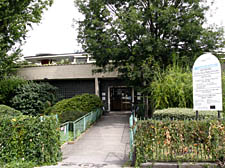|
|
 |
| |

The listed building in Pine Street |
Pioneers’ dream centre that led the way for the National Health
Historic ‘people’s clinic’, an early example of radicalism, now faces privatisation threat
THE Finsbury Health Centre was opened in 1938 by a radical Labour council founded on socialist principles that would later become the bedrock of the National Health Service.
The health centre – where doctors worked side-by-side with nurses, social workers, radiographers and physiotherapists – was based on a “polyclinic” model pioneered in the Soviet Union.
It was part of the council’s radical Finsbury Plan, aiming to redress shocking deprivation in a working class population.
For the first time in England, more than 20,000 patients from the “People’s Republic of Finsbury” could find a range of healthcare and education services in one centralised hub.
Its architect, the Georgian émigré Berthold Lubetkin, proclaimed “nothing is too good for ordinary people” and, as archive documents unearthed by the Tribune show, actually advised Health Minister Aneurin Bevan as he set about creating the NHS.
On its opening, the Finsbury mayor Alderman H Riley proudly described the building as the “pride of the borough”.
More than 70 years on, Islington Primary Care Trust – headed up by former Islington Council leader Steve Hitchens – says it can no longer afford to maintain the Grade I listed building and plans to sell the building to a private developer.
The plans – which will go out for consultation in September – have been met with fierce criticism, especially at a time when the Labour government is pressing ahead with plans to open 150 polyclinics across the country.
Finsbury ward was, and still is, considered one of the most deprived wards in London.
Sharon Hayward, Independent Working Class Association representative for Clerkenwell, said: “While the opening of the building was symbolic of the political radicalism of the authorities in Finsbury at that time, preceding the commencement of the National Health Service by 10 years, the planned sell-off is equally symbolic of the authorities’ determination now to privatise or sell everything and anything that services the needs of Finsbury’s working class community.”
Not only did the health centre precede the NHS by 10 years, it helped to shape it.
In 1946 delegates from the Health Workers Council (HWC) visited the Finsbury Health Centre to discuss how it could shape a national health service.
They were gathering evidence for a white paper proposed by Health Minister Aneurin Bevan on the creation of the service.
A report of the conference is stored in Warwick Library Archive Centre and shows the impact the Finsbury pioneers had on the policy-makers.
The debate revealed to for the first time “how important a part the local health centre plays in the lives of the people.
“Since the borough was a very poor working-class area, the services left much to be desired before they had the centre. People certainly did not consider that advice on health matters came within the function of the health department. The establishment of the health centre had quite changed this attitude, and the building, planned in careful consultation between the architect and the medical officer of health [Dr A B Stewart] was the pride of the borough.”
The building was started in 1937 and finished in 1938.
The cost was £70,000, which included apparatus, equipment and furnishing, X-ray items and laboratory and two dental chairs.
The HWC were taken on a tour of the centre where they reported the building was “admirably suited for its purpose” and a “very pleasant place for any patient to have his troubles seen to and any health worker to work in”.
A “most excellent tea” was enjoyed by the delegates before the mayor took the party to the lecture hall for discussion.
The mayor distinguished between other health centres “springing up” in south London: “Finsbury’s was the only non-private centre and the only one with doctors on site”.
Group medical practice was also fairly common, “but this had disadvantages as long as the patient had to pay fees to each doctor”.
The discussion centred on ambitious plans to have periodical examinations of all patients, and better health education provided for all.
The difficulty of staffing (there was a shortage of doctors at the time) was brought up and calls were made for women to be allowed to train at medical school.
The model to be proposed in the HWC’s White Paper would be for health centres to cover 20,000 patients and to be staffed by 10 to 12 doctors.
The report ends: “When the conference closed everyone felt very much more clear on the possibilities of local health centres.”
Few health centres like Finsbury have opened over the past 60 years after the cost of NHS spiralled unexpectedly. The government were caught on the back foot and cuts to the original programme was made.
The current Health Secretary Alan Johnson has announced plans to open 150 polyclinics across the country.
At this year’s celebration of the 60th anniversary of the NHS he said opening polyclinics would be “realising Bevan’s dream”.
But it is clear that, unlike the Finsbury Health Centre, the new raft of polyclinics will be run by private firms like Virgin or UnitedHealth.
Islington health campaigner Wendy Savage of Keep Our NHS Public said: “All our worst fears that polyclinics were going to be built or run by the private sector are coming true.
“Private companies are not suitable to run healthcare. It is not like selling baked beans.” |
 |
|
 |
| |
Your comments:
|
| |
| |
|
 |
|